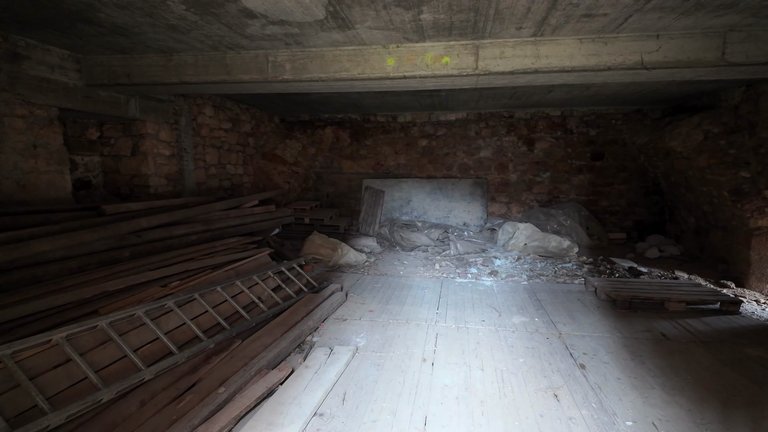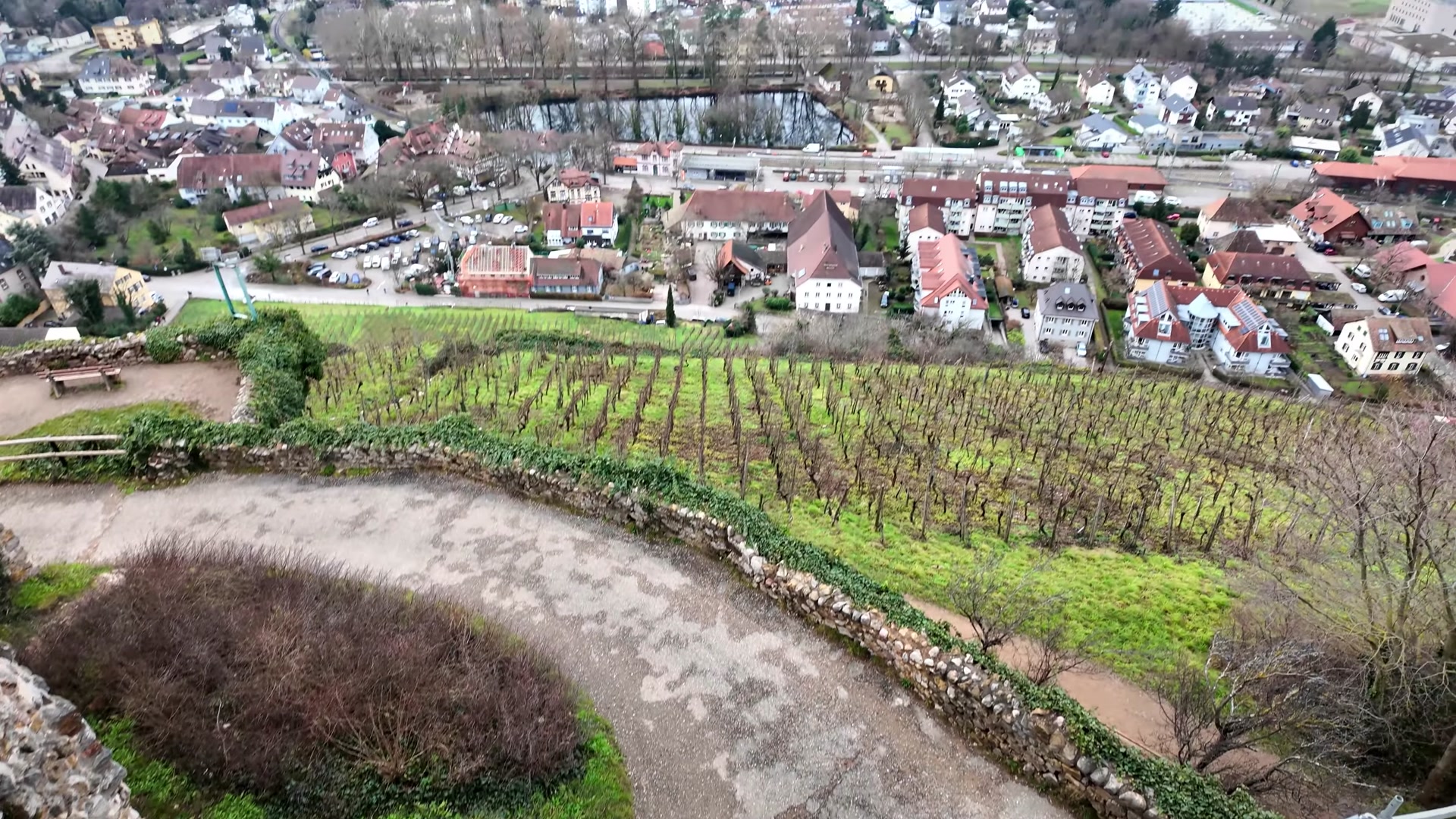
Hello everyone. Today we're sharing our experience from Staufen, a small and charming German town near Freiburg. This town is home to a castle ruin and today we embarked on a journey to explore it. Afterward we strolled through the town and had a wonderful day.

We chose the easiest route to the castle. Following a paved road with gentle curves. There’s actually a shorter path with stairs for those who want to take a direct route. As we slowly ascended, the entire town seemed to lie in the palm of our hands.


On our way up we passed by vineyards at every turn. I can only imagine how beautiful this place must be during spring. The panoramic view is breathtaking and the air is crystal clear.



As we continued our climb we approached the castle ruins. From a distance, we could already see its walls and empty windows, almost as if they were watching us. These windows offer stunning views of the town below. There’s even a telescope at the observation area. you can use it by inserting a coin to get a closer look at the surroundings. Thoughtfully a bench and a trash bin have been placed there for visitors to rest.

It’s December now, the middle of winter. ❄️ The temperature is around 5–6°C, yet the grass remains vividly green. This is what a German town looks like in December. We’re dressed for the weather, enjoying the scenery and sharing interesting spots with our followers. Learning how people live in different countries and cities is always fascinating to us.

Ruins like this give you a tangible sense of history. Look at the materials used to build this place. The walls are made of stones with embedded seashells and bricks. It’s quiet, peaceful and serene here. Life in this area flows at a slow, steady and tranquil pace.

People here start their coffee breaks a bit later compared to other German cities. Typically around 10 or 11 in the morning. They gather at cafés to enjoy coffee, croissants and pastries.
The castle ruins are the main attraction of this town, drawing visitors from far and wide. We saw a small passage that looked like a dungeon. We’re trying to figure out what it might have been. Perhaps it was a storage area since there are no doors or other visible passageways. It might have been used to store ammunition or other supplies.


It’s clear that iron doors once existed here because you can still see the hinge marks. However, the wall is completely sealed off beyond the corner. We continued on, eagerly anticipating entering through the main gate.

Finally, we reached the castle’s main entrance. This is the gateway to the interior. Looking inside, you can see how fascinating the structure is. Just above the main arch, there’s evidence of a second floor. Likely a room once stood there. The stairs are still intact, allowing you to climb up.


Exploring the castle gives us a sense of its grandeur. It was a tall structure, probably three or four stories high, though some levels have collapsed over time. What remains resembles a three-story building. The walls feature massive window openings and one even looks like it led to a balcony. Such large windows are unusual for a castle.

Staufen Castle is a remarkable place where history, nature and tranquility come together. It’s no wonder visitors from different cities and countries are drawn to it.

Looking down from the castle, the entire town of Staufen feels as though it rests in the palm of our hands. The views below are truly mesmerizing. On one of the walls, there’s an inscription from 1906, likely marking a restoration carried out at that time. As we peered into the castle's interior, we guessed it might have once been a courtyard, surrounded by rooms and large structures. These rooms may have served as living quarters for servants or soldiers guarding the castle.


One striking detail is the arrangement of windows on the walls. Lined up in different sizes, one above the other. Some are large, others smaller and a few have been bricked up over time. While the interior walls are relatively smooth, many of the stones used in construction are unshaped, offering clues about the era in which the castle was built.




As we explored further, a more modern-looking structure caught our attention. It seemed to have been added later and we were eager to look inside. The interior featured a window for lighting and a wooden floor. Imagining what this space might have been used for in the past was intriguing.


Nearby we noticed a tourist taking photos from one of the towers. So, we weren’t alone after all. From the outside, the structure reveals walls at least a meter thick, possibly two meters in some areas. These walls were likely built to separate and protect the castle from the outside world. On this side, the walls are significantly thicker, suggesting it was a defensive barrier. A lookout tower here must have been used to survey the surroundings.



We decided to climb higher to take in the view from the top. As we approached the stairs, a sign informed us that the castle was first mentioned in written records in 1248, though it was originally built in the 10th century. The walls, measuring about three meters thick, are an impressive testament to its sturdy construction. Walking these ancient stairs feels like stepping back in time, connecting us to a history that spans over a millennium.


The stairs themselves show signs of wear from centuries of use. Thinking about the people who once climbed these steps is both thrilling and humbling. As we ascended, we noticed remnants of elegant columns and archways, hinting at the castle’s former grandeur.



At one corner of the castle, we found arched windows on either side. one large, the other smaller. This corner offered a dual view, indicating the castle was double-walled, with an inner and outer courtyard. The main building, likely the residence of the castle's owners, was visible from here. The watchtower, possibly located here, provided a commanding view of the surrounding areas, including the vineyards and even the borders of France and Switzerland on clear days.



Looking down from the heights is dizzying, especially for those with a fear of heights. The spiral staircase descends steeply, with some steps reinforced with modern concrete for safety. Despite the nerves, the view from above is breathtaking, offering a panorama of the town, the castle ruins and the vineyards stretching into the horizon.












Descending the stairs was more challenging than expected, requiring careful balance and attention. The narrow paths and uneven stones added to the adventure. As we reached the base of the hill, we passed through vineyards, imagining how delightful it would be to visit during harvest season, tasting ripe grapes and enjoying the fresh air.








In the town below, we came across a bronze statue of Bacchus, the god of wine, holding a bunch of grapes. Created in 1970, the statue gleamed in places where visitors had touched it. During the grape harvest, fresh wine reportedly flows from an opening beneath the statue. A delightful tradition that brought a smile to our faces.


The town itself was beautifully decorated for the New Year, with handmade ornaments crafted from pinecones, mushrooms and recycled materials. 🎅 Some decorations were made by local seniors, adding a heartfelt touch. We visited an open-air museum featuring an old grape press used for winemaking. The manual process of squeezing grape juice with a large lever highlighted the effort behind traditional winemaking.










Walking through the main street, we admired creatively decorated Christmas trees, each reflecting the unique style of local organizations. We crossed an old iron bridge with vintage bolts and rivets, a perfect spot to sit with coffee and pastries from a nearby bakery.











Today’s journey through Staufen’s 10th-century castle ruins and vineyards was a memorable adventure. We hope you enjoyed exploring this historic town with us. Stay tuned. There’s so much more to discover. See you next time. ❄️














